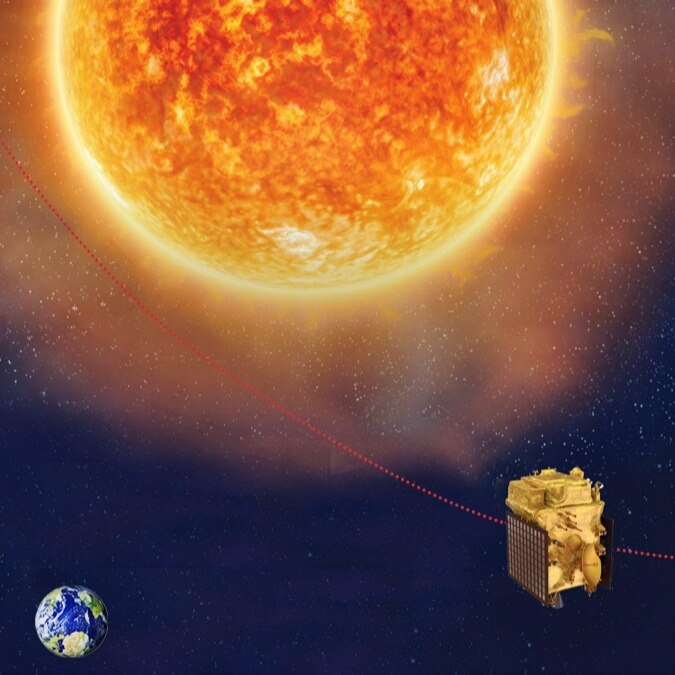
The Indian Space Research Organisation is set to execute a key manoeuvre on Saturday, where it will command thrusters to fire and position the Aditya L1 spacecraft, India’s first space-based solar observatory, into its designated orbit approximately 15 lakh kilometres away from Earth.
Hindustan Times Digital spoke to Manish Purohit, a former ISRO scientist and founder of NIMBUS Education, to understand the intricate details of the Sun mission. Purohit has expertise in critical space missions like Chandrayaan-2 and Mangalyaan.
Here’s the edited excerpt:
During Aditya L1’s 127-day journey, what were the crucial milestones and challenges encountered?
• On September 19, Aditya L1 undertook a manoeuvre to beat Earth’s gravity and leave its sphere of influence to move towards the Lagrangian point.
• On October 6, Aditya L1 adjusted its course using onboard thrusters to ensure it stayed on the right path to the L1 point.
• As the solar probe moved away from Earth, it required constant observation. For that, the ISRO got help from ground stations from the European Space Agency which kept track of its position and speed.
• Specialised software played a key role, in making sure Aditya L1’s movements were calculated and precise. This ensured that important events, like placing Aditya in the Lagrangian point 1 halo orbit at 4 pm, were well-planned.
What’s ISRO’s game plan to get Aditya L1 into its final orbit at 4 pm Saturday?
Let me draw a comparison with Chandrayaan 3 to provide a clearer understanding. On July 14, when Chandrayaan 3 was launched, it orbited the earth to elevate its orbit, similar to what we did for Aditya L1.
Chandrayaan 3 commenced its journey to the moon on July 31, a phase known as translunar injection. By August 5, we received confirmation that Chandrayaan had been captured by the moon’s gravity. On this pivotal day, we manoeuvred to change the spacecraft’s orientation.
When moving away from earth, thrusters at the back propel the spacecraft forward. However, when aiming to be captured by another celestial body’s gravity, we perform a 180-degree flip, bringing the thrusters to the front to slow down the spacecraft. This standard procedure was applied in Chandrayaan 3 and our Mars Orbiter Mission.
Tomorrow, the same manoeuvre will be repeated for the Aditya L1 probe, but it should be noted that there is no celestial body to catch it but a void around which it has to orbit. Also, unlike the intense 17 minutes of terror during the lunar landing, this manoeuvre will last only a few seconds.
The crucial thing here is that since the last firing of our liquid apogee motor a couple of months ago, the motors are currently in a hibernated state due to the cold space environment. The key is to ensure that when commanded, the motors wake up promptly, fire for the intended duration, and execute the manoeuvre precisely at the crucial moment. This requires precision to avoid overdoing, underdoing, or mistiming the motor firing.
So, when Aditya L1 reaches its special halo orbit, is everything pretty smooth sailing from there, or are there still some challenges to deal with?
• Once Aditya L1 is placed in the halo orbit, it faces unique challenges due to the complex 3D nature of this orbit. Unlike typical orbits, the halo orbit is highly convoluted as it revolves around the dynamically moving L1 point, which is itself in motion along the earth-sun line. This adds complexity as Aditya orbits a point that is not stationary but shifts with earth’s movement around the sun.
• The L1 point represents an unstable equilibrium, akin to standing on a hill where a slight push can lead to descent. Continuous monitoring is essential due to this instability. Aditya L1’s thrusters play a crucial role in maintaining the spacecraft’s attitude and orbital control, ensuring it stays in the halo orbit.
•To counter the instability, control moment gyros are employed, similar to those used by the International Space Station for orientation. These gyros help balance the spin, contributing to altitude and orientation maintenance. The spacecraft’s software continuously monitors these parameters, with ground stations providing crucial information about its position and orbital details.
•Collision avoidance is another challenge. Aditya L1 must navigate its orbit to prevent collisions with other missions or spacecraft, requiring meticulous planning and execution. These complexities highlight the intricate dance of orbital dynamics that Aditya L1 must master to fulfil its mission successfully.
What’s the scenario if Aditya L1 doesn’t make it to its intended orbit on Saturday?
Think of it like Russia’s Luna 25 where a glitch in the firing of motors caused a lunar crash landing. Now, while Aditya L1 won’t be crash-landing on anything as there is nothing. if we overshoot or undershoot that sweet spot in the expected orbit range, trouble brews.
We might miss the gravity capture by the L1 point, throwing us off the desired orbit. If we can’t slow down properly, we risk ending up in a higher orbit. The consequence? More fuel burnt, and with fuel being most important for mission life, that’s not something we want.
A precise journey means more fuel for future operations. A little extra propellant allows us to experiment, as we did with Chandrayaan-3’s propulsion module, which can make a big difference in future missions.
What is the biggest outcome we are hoping to see from Aditya L1 mission?
Well, it’s all about understanding space weather. You see, space weather has a say in how things work on Earth. Considering the surge in satellite missions like Starlink and others, spacecraft are becoming a huge part of our daily lives, from disaster warning systems to earth observation and city planning.
Now, imagine this: if the sun decides to throw out some high-energy radiation or particles, being stationed at the L1 point gives us a heads-up about an hour before it hits earth. It’s like having an early warning system. The better we understand the sun, the more prepared we are for such situations. But that’s not all – Aditya L1’s mission isn’t just about warnings; it’s also about showcasing our space exploration capabilities and lending a helping hand to academia with some valuable data.

